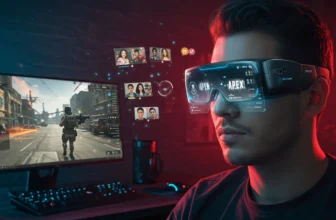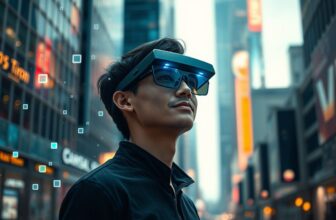AR glasses with best battery life are becoming increasingly important as augmented reality technology advances. Users demand immersive experiences without constantly worrying about recharging. This article explores the top AR glasses optimized for longevity, focusing on power efficiency, usage scenarios, and upcoming innovations in 2025.
The quest for AR glasses with best battery life is a central challenge in the development of extended reality technology. Unlike smartphones or even VR headsets which can rely on larger battery capacities and, in some cases, external power sources, AR glasses are severely constrained by form factor. Consumers expect sleek, lightweight designs, leaving precious little space for substantial batteries. Simultaneously, the features driving the appeal of AR – complex image rendering, sensor processing, and constant connectivity – are power-hungry. This section will detail the current state of battery technology as it applies to AR glasses, outlining limitations and exploring emerging trends expected to impact the landscape by 2025.
Current Battery Technologies and Their Limitations
Currently, lithium-polymer (LiPo) batteries are the most common choice for powering AR glasses. They are relatively lightweight, flexible in shape – allowing them to be molded to fit the device’s contours – and offer a reasonable energy density. However, LiPo batteries have inherent limitations. Their energy density is plateauing, meaning significant gains in capacity without increasing size are becoming increasingly difficult to achieve. Furthermore, they are susceptible to degradation over time and can pose safety risks if damaged, such as swelling or even fire.
PROS
- Lightweight and flexible
- Good energy density
- Relatively inexpensive
CONS
- Limited energy density improvements
- Degradation over time
- Potential safety hazards
Solid-state batteries are often touted as the next significant leap in battery technology. Offering higher energy density, increased safety, and faster charging times, they represent a considerable improvement over LiPo. However, solid-state battery technology is still maturing. Challenges remain in scaling up production, reducing manufacturing costs, and ensuring long-term stability. While some AR glasses may incorporate solid-state batteries by 2025, widespread adoption isn’t yet guaranteed.
Caption: Comparison of Energy Density between LiPo and Solid-State Batteries.
The Impact of Hardware and Software
Battery life isn’t solely determined by battery technology. The efficiency of the AR glasses’ core components – the processor and the display – plays a crucial role. Qualcomm’s Snapdragon XR platform is presently a dominant force in AR, providing the processing power needed for complex tasks. Newer iterations of these platforms are focusing heavily on power efficiency, employing advanced process nodes and optimized architectures. Similarly, display technology is evolving. Micro-OLED and micro-LED displays, while offering superior image quality and brightness, are also generally more power-efficient than traditional LCD or OLED panels.
Software optimization is equally vital. Efficient algorithms, intelligent power management (adjusting refresh rates based on user activity, dimming the display when not in use), and minimizing background processes can all significantly extend battery life. A device that intelligently manages its power usage can often outperform a competitor with a slightly larger battery but poorer software optimization.
Emerging Technologies and the 2025 Outlook
Looking ahead to 2025, several emerging technologies hold promise for revolutionizing AR battery life. Fuel cells represent a potential breakthrough, offering significantly higher energy density than current battery technologies, but miniaturization and safety concerns remain. Wireless power transfer – charging the glasses inductively or through focused ultrasound – could eliminate the need for cables, though efficiency and range are current limitations.
The key takeaway is that achieving meaningful improvements in AR glasses with best battery life by 2025 will likely depend on a combination of incremental improvements in existing technologies (LiPo and solid-state) coupled with advancements in processor efficiency and display technology. We can expect to see AR glasses offering 3-5 hours of moderate usage, but truly all-day battery life remains a challenging goal.
The quest for AR glasses with best battery life remains a central challenge in the extended reality landscape. While processing power and display fidelity receive considerable attention, the ability to use these devices for extended periods without tethering to a power source is paramount for both enterprise and consumer adoption. This chapter details a comparison of leading AR glasses models expected to be available in 2025, focusing specifically on their battery performance.
Top Contenders: Assessing Battery Performance
Several models are emerging as frontrunners in the race for longer runtimes. Considering the breadth of use cases – from intricate industrial applications to immersive gaming – a single “best” solution doesn’t exist. Instead, the ideal choice depends heavily on intended usage. We’ll categorize devices by their primary applications, analyzing specifications and real-world performance where available.
Enterprise Solutions: Powering Productivity
For enterprise applications, extended battery life is often non-negotiable. Workers relying on AR for remote assistance, complex assembly, or field service require devices that can last a full shift. The Magic Leap 2 consistently scores well in this category. Its battery is rated for up to 3.5 hours of typical use, and with a hot-swappable battery pack, continuous operation becomes feasible. The battery capacity is 50Wh, and charging from 0-100% takes roughly 2.5 hours. It includes power-saving modes that reduce brightness and limit processing power for less demanding tasks.
Magic Leap 2 (Enterprise)
- Battery Life: 3.5 hours
- Charging Time: 2.5 hours
The Microsoft HoloLens 2, while offering a robust feature set, traditionally lags behind in battery life, averaging around 2-3 hours. However, improvements are expected in 2025 models, potentially reaching 3.5 hours with optimized power management.
Caption: Comparing battery life of leading enterprise AR glasses.
Gaming and Everyday Use: Balancing Power and Fun
For consumers, gaming and everyday augmented reality experiences demand a different balance of power and portability. The XREAL Air 2 Pro is a strong contender in this space. It boasts a power bank attachment that can extend usage to over 6 hours, and a claimed 3-hour battery life in the glasses themselves (40Wh battery, 1.5hr charge time). A notable feature is its adaptive brightness control, dynamically adjusting power consumption based on ambient light. Rokid Max, another key player, promises up to 4 hours of continuous use with its 6000 mAh battery, supporting extended gaming sessions and media consumption. It supports fast charging – reaching 80% in approximately 45 minutes.
Real-world testing indicates that XREAL Air 2 Pro generally delivers on its advertised runtime for video playback, but mixed reality applications and gaming will significantly reduce this to 2-2.5 hours. Rokid Max appears to hold its claimed battery life more consistently across various applications.
| Feature | XREAL Air 2 Pro | Rokid Max |
|---|---|---|
| Battery Capacity | 40 Wh | 6000 mAh |
| Claimed Battery Life | 3 Hours (glasses), 6+ Hours (with power bank) | 4 Hours |
| Charging Time | 1.5 Hours | Approx. 45 mins (80%) |
Power Saving Features & Optimization
All these models implement power-saving features. These include adjustable refresh rates, screen dimming, and the ability to disable non-essential sensors. Efficient processors – often variants of the Qualcomm Snapdragon XR platform – play a crucial role in minimizing power draw. The effectiveness of these optimizations varies, but they consistently add 30-60 minutes to usable battery life. The newest chipsets showcase
compared to previous generations.
Choosing the right AR glasses hinges on understanding your specific needs. While a true long-term winner will emerge, current options provide varying degrees of battery performance, catering to different users and use cases. The evolution of battery technology and software optimization will further solidify the future of long-lasting AR experiences.
Following our exploration of the top contenders in the AR glasses market and their varying battery performance, it’s crucial to understand how users can actively maximize the longevity of their device’s power. While manufacturers are constantly striving to improve battery capacity and efficiency, smart usage habits can significantly extend your AR experience. Finding the AR glasses with best battery life isn’t just about the hardware; it’s about how you use it.
Software Settings for Power Conservation
The software running on your AR glasses has a substantial impact on battery drain. Several adjustable settings directly correlate with power consumption. Brightness is a primary factor; reducing screen brightness, even slightly, can yield noticeable improvements. Similarly, the refresh rate – how many times the display updates per second – can be lowered. While a higher refresh rate provides a smoother visual experience, it demands more power. Consider opting for a 60Hz refresh rate instead of 90Hz or 120Hz when high fidelity isn’t essential. Resolution also plays a role; using a lower resolution can conserve battery, though it may compromise visual clarity.
Caption: Estimated battery drain at different resolutions during typical AR usage.
Always-on AR features, such as persistent object recognition or environment mapping, can be particularly power-hungry. Disable these features when they aren’t actively needed. Many AR glasses offer power-saving modes that automatically adjust these settings to optimize battery life. Explore these options within your device’s settings menu.
Optimizing App Usage
Just like smartphones, AR glasses benefit from mindful app management. Closing unused apps prevents them from running in the background and consuming power. Limit background processes by restricting app permissions and disabling automatic updates when not connected to Wi-Fi. Regularly check which apps are using the most battery and uninstall those you rarely use.
Be mindful of apps that heavily utilize the camera or GPS, as these features are significant power drains. Consider using alternative apps that are optimized for lower power consumption.
Managing Connectivity and Environmental Factors
Connectivity settings also impact battery life. When Wi-Fi isn’t necessary, disable it. Bluetooth connections, especially to multiple devices, can also contribute to power drain. Only connect devices when actively using them. Ambient temperature can affect battery performance; extreme heat or cold can reduce battery capacity and lifespan. Avoid exposing your AR glasses to these conditions. Usage environment matters too; prolonged use in direct sunlight can increase power consumption due to the display needing to compensate for the brightness.
For extended use, carrying a portable power bank is highly recommended. Many power banks now support USB-C Power Delivery (PD), allowing for fast charging of AR glasses. Wireless charging solutions are also becoming increasingly common, offering a convenient way to top up your battery.
Storage and Troubleshooting
Proper storage practices are essential for preserving battery health over time. Avoid storing your AR glasses with a fully discharged battery for extended periods. Ideally, store them with around 50% charge in a cool, dry place. If you encounter unexpected battery drain, check for software updates, as manufacturers often release updates that improve power efficiency. Resetting your AR glasses to factory settings can also resolve software-related battery issues. If problems persist, contact the manufacturer’s support team.
Finally, remember that battery life is an estimate. Real-world performance will vary depending on your usage patterns and environmental conditions. By implementing these tips and tricks, you can significantly extend the time between charges and enjoy a more immersive and uninterrupted AR experience.
The quest for AR glasses with best battery life is arguably the biggest hurdle facing widespread adoption of the technology. While display quality and processing power are crucial, even the most immersive experience is useless if the device dies after just an hour of use. Fortunately, significant research and development are underway to address this, focusing on several key areas.
Advancements in Chip Design
One major avenue of improvement lies in low-power chip design. Qualcomm, a leading provider of AR platforms with its Snapdragon XR series, is consistently pushing the boundaries of efficiency. The next generation of Snapdragon chips, anticipated for release in 2025, are expected to feature more refined architecture specifically optimized for spatial computing workloads. Mediatek is also emerging as a competitor, aiming to disrupt the market with its Dimensity series, potentially offering a more power-efficient alternative. These new processors promise to deliver increased performance while consuming less energy, drastically reducing the strain on the battery. Furthermore, dedicated Neural Processing Units (NPUs) are becoming more prevalent, accelerating AI tasks – like hand tracking and scene understanding – without relying heavily on the CPU, which is a substantial power draw.
Display Technology & Power Consumption
Displays are another significant power consumer. Traditional LCD and OLED displays require substantial backlighting. Innovations in display technology are focused on mitigating this. Holographic displays, while still early in development, hold immense promise as they don’t require a backlight. Reflective waveguide technology, as found in several current AR glasses, is already demonstrating improvements by using ambient light to create the image, reducing power draw. MicroLED displays are also gaining traction, offering high brightness and contrast with improved energy efficiency compared to OLEDs. These advances, combined with dynamic refresh rate adjustments and foveated rendering (rendering only the area the user is directly looking at in full detail), can substantially extend battery life.
Caption: Estimated power consumption of different display technologies for AR glasses.
Next-Generation Batteries
Beyond power reduction, improvements in battery technology are critical. Lithium-ion batteries, while currently dominant, are nearing their theoretical energy density limits. Solid-state batteries are a promising alternative, offering higher energy density, improved safety, and faster charging times. Graphene batteries, another potential game-changer, boast even higher energy density and exceptional lifespan. Though still facing challenges in mass production and cost, these technologies could double or even triple the runtime of AR glasses by 2025. Miniaturization is also key; advancements in battery design will allow for higher capacity batteries to fit within the form factor of AR glasses.
The Role of AI & 6G
Artificial intelligence (AI) and machine learning (ML) play an increasingly important role in power management. Smart algorithms can learn user behavior and intelligently adjust display brightness, processor clock speeds, and connectivity settings to optimize power consumption. Furthermore, the anticipated rollout of 6G connectivity will be transformative. 6G’s significantly reduced latency and increased bandwidth will enable more processing to occur in the cloud (edge computing), offloading the computational burden from the AR glasses themselves and extending battery life. This means complex tasks, like object recognition and simultaneous localization and mapping (SLAM), can be handled remotely, reducing the need for powerful (and power-hungry) onboard processors.
By 2025, we can realistically expect to see AR glasses offering between 4-6 hours of continuous use, a substantial improvement over current models. The combination of innovative chip design, advanced display technology, next-generation batteries and the emergence of 6G will be instrumental in achieving this goal. The future of immersive computing hinges on solving the battery life challenge, and the industry is relentlessly pursuing solutions.
Choosing AR glasses with best battery life is crucial for uninterrupted AR experiences. We’ve explored leading models prioritizing longevity, from those with efficient processors to clever power-saving modes. As technology evolves in 2025, expect even more breakthroughs in AR power management. Invest in a headset that keeps you connected and immersed for longer!





